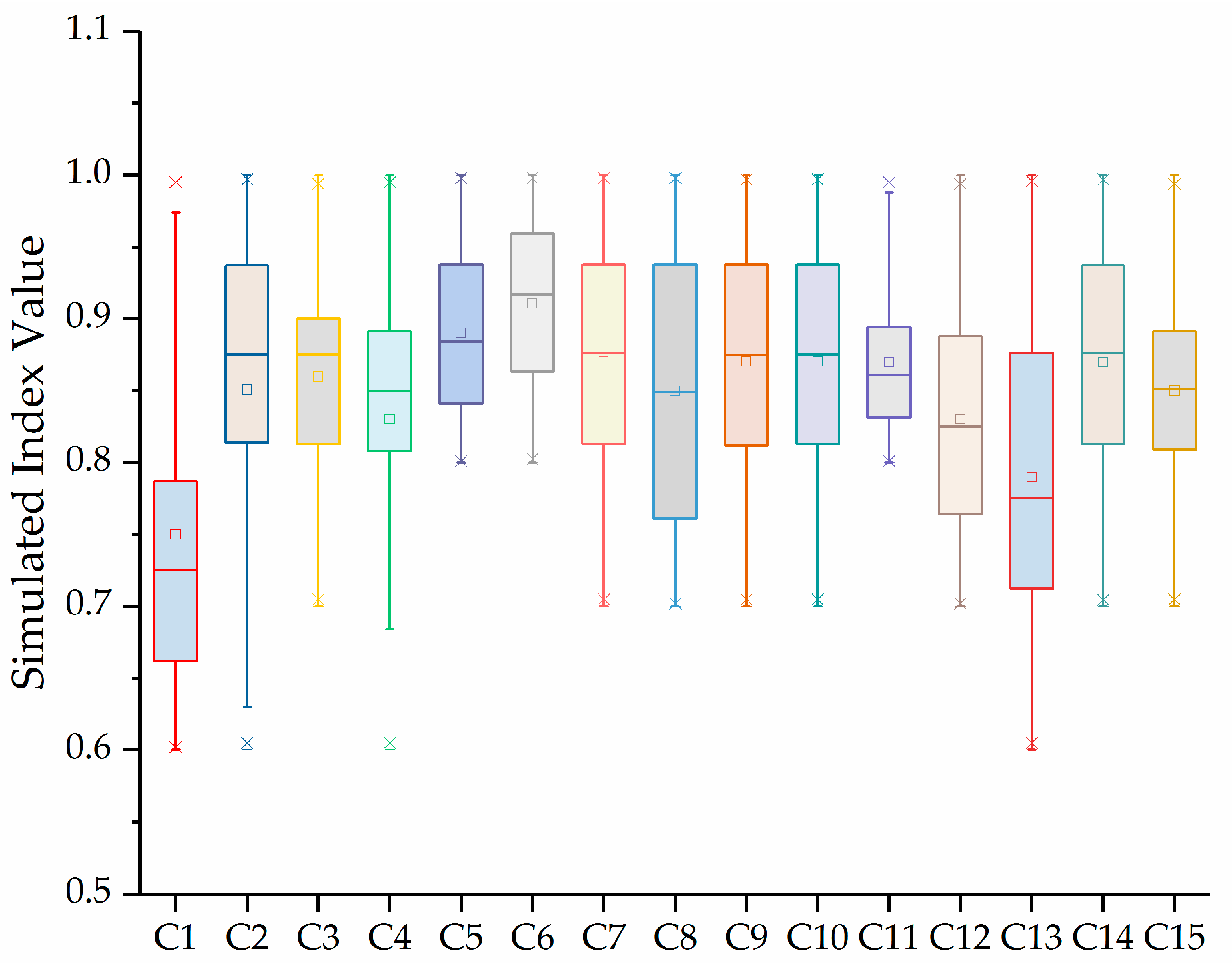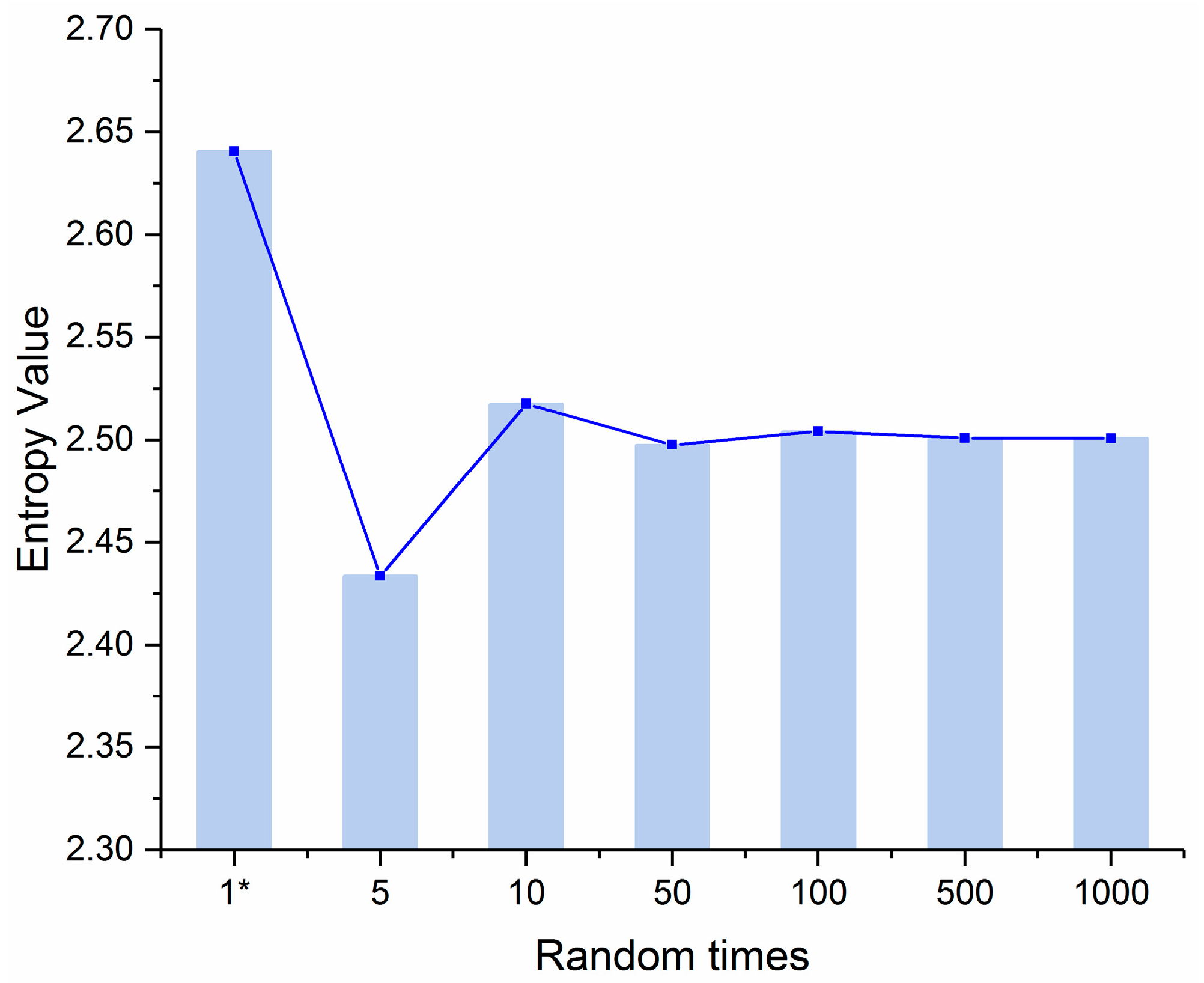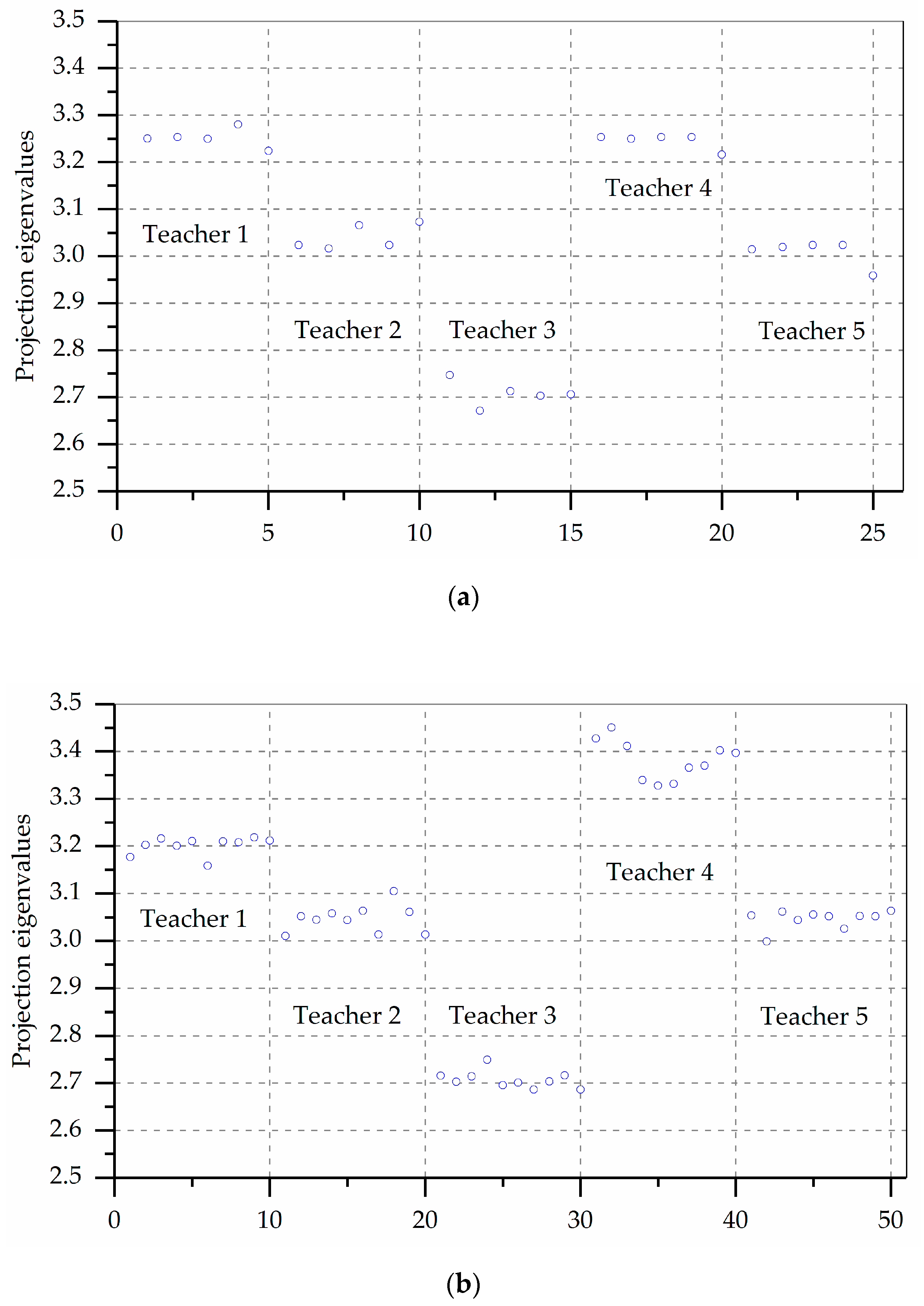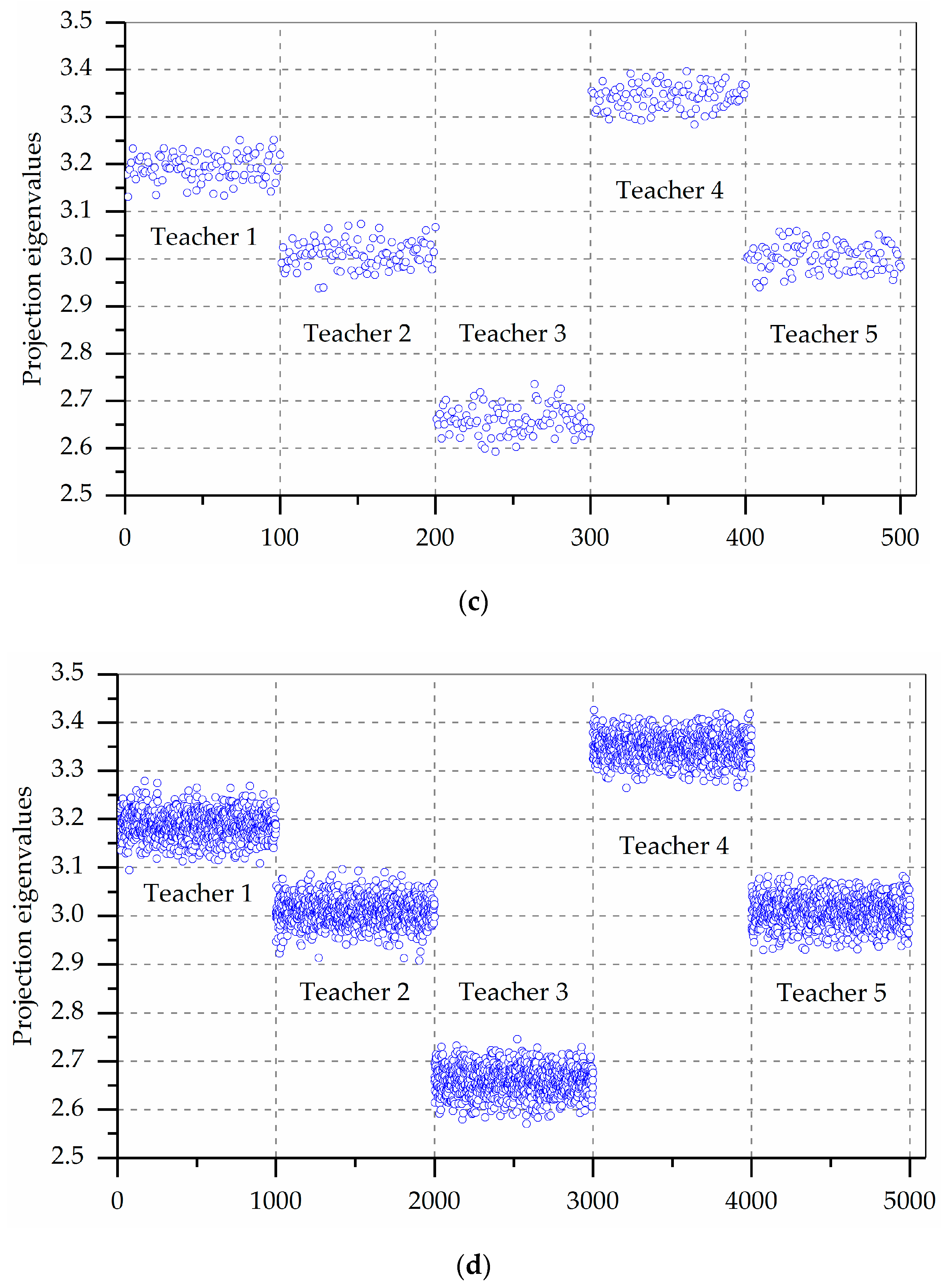Entropy Value-Based Pursuit Projection Cluster for the Teaching Quality Evaluation with Interval Number
Abstract
:1. Introduction
2. Materials and Methods
2.1. Monte Carlo Simulation for Interval Teaching Quality Index
2.2. Entropy Value of Evaluation Index Weight
2.3. Projection Pursuit Cluster
2.4. The Index System of Teaching Quality Evaluation
3. Results and Discussions
3.1. Monte Carlo Simulation of Interval Number
3.2. Results of the Indicator Weights of Projection Pursuit Cluster
3.3. Evaluation of Each Alternative Teacher
3.3.1. Scatter Plot of Each Teacher
3.3.2. Statistical Analysis of Projection Eigenvalues
3.4. Discussion of the Evaluation Results
3.4.1. Comparisons with Other Methods
3.4.2. Advantages of the Proposed Method
4. Conclusions
Author Contributions
Funding
Acknowledgments
Conflicts of Interest
References
- Hanushek, E.A.; Woessmann, L. Education Quality and Economic Growth; World Bank: Washington, DC, USA, 2007. [Google Scholar]
- Warman, S.M. Challenges and Issues in the Evaluation of Teaching Quality: How Does it Affect Teachers’ Professional Practice? A UK Perspective. J. Vet. Med. Educ. 2015, 42, 245–251. [Google Scholar] [CrossRef] [PubMed]
- Martinez, F.; Taut, S.; Schaaf, K. Classroom observation for evaluating and improving teaching: An international perspective. Stud. Educ. Eval. 2016, 49, 15–29. [Google Scholar] [CrossRef]
- Feldman, K.A. The superior college teacher from the student’s view. Res. High. Educ. 1976, 5, 243–288. [Google Scholar] [CrossRef]
- Marsh, H.W. SEEQ: A reliable, valid, and useful instrument for collecting students’ evaluations of university teaching. Br. J. Educ. Psychol. 1982, 52, 77–95. [Google Scholar] [CrossRef]
- Luque, M. Evaluating the global efficiency of teachers through a multi-criteria approach. Socio-Econ. Plan. Sci. 2018. [Google Scholar] [CrossRef]
- Zhang, J.X.; Schmidt, K.; Li, H. BIM and Sustainability Education: Incorporating Instructional Needs into Curriculum Planning in CEM Programs Accredited by ACCE. Sustainability 2016, 8, 525. [Google Scholar] [CrossRef]
- Ndukwe, I.G.; Daniel, B.K.; Butson, R.J. Data Science Approach for Simulating Educational Data: Towards the Development of Teaching Outcome Model. Big Data Cogn. Comput. 2018, 2, 24. [Google Scholar] [CrossRef]
- Xu, Z.S. An overview of interval-valued intuitionistic fuzzy information aggregations and applications. Granul. Comput. 2017, 2, 13–39. [Google Scholar] [CrossRef]
- Sengupta, A.; Pal, T.K. On comparing interval numbers. Eur. J. Oper. Res. 2000, 127, 28–43. [Google Scholar] [CrossRef]
- Liu, X.Q.; Chen, X.; Chen, Y. Teaching qualify evaluations of college teachers based on group consensus. Comput. Eng. Appl. 2009, 45, 230–233. [Google Scholar]
- Zhang, M.L. Application of interval number multiple attribute decision making in the evaluation of classroom teaching quality. J. Ningde Normal Univ. 2014, 26, 178–182. [Google Scholar]
- Zhao, X.F. TOPSIS method for interval-valued intuitionistic fuzzy multiple attribute decision making and its application to teaching quality evaluation. J Intell. Fuzzy Syst. 2014, 26, 3049–3055. [Google Scholar]
- Jahanshahloo, G.R.; Hosseinzadeh Lotfi, F.; Izadikhah, M. Extension of the TOPSIS for decision-making problems with fuzzy data. Appl. Math. Comput. 2006, 181, 1544–1551. [Google Scholar] [CrossRef]
- Jahanshahloo, G.R.; Hosseinzadeh Lotfi, F.; Izadikhah, M. An algorithmic method to extend TOPSIS for decision-making problems with interval data. Appl. Math. Comput. 2006, 175, 1375–1384. [Google Scholar] [CrossRef]
- Fouskakis, D.; Petrakos, G.; Vavouras, I. A Bayesian hierarchical model for comparative evaluation of teaching quality indicators in higher education. J. Appl. Stat. 2015. [Google Scholar] [CrossRef]
- Gu, P.P.; Zheng, Y.H. Cluster Analysis on the Teaching Evaluation Data from College Students. In Proceedings of the the 13th International Conference on Computer Science & Education (ICCSE 2018), Colombo, Sri Lanka, 8–11 August 2018; pp. 839–844. [Google Scholar]
- Dong, J.Y. Interval number method for teaching quality evaluation of college teachers. Comput. Eng. Appl. 2010, 46, 246–248. [Google Scholar]
- Chen, J.F.; Hsieh, H.N.; Do, Q.H. Evaluating teaching performance based on fuzzy AHP and comprehensive evaluation approach. Appl. Soft Comput. 2015, 28, 100–108. [Google Scholar] [CrossRef]
- Shen, L.Q.; Yang, J.; Jin, X.Y.; Hou, L.Y.; Shang, S.M.; Zhang, Y. Based on Delphi method and analytic hierarchy process to construct the evaluation index system of nursing simulation teaching quality. Nurse Educ. Today 2018. [Google Scholar] [CrossRef]
- Zhang, M.; Zhou, J.H.; Zhou, R.J. Evaluating sustainability of regional water resources based on improved generalized entropy method. Entropy 2018, 20, 715. [Google Scholar] [CrossRef]
- Cui, Y.; Feng, P.; Jin, J.L.; Liu, L. Water resources carrying capacity evaluation and diagnosis based on set pair analysis and improved the entropy weight method. Entropy 2018, 20, 359. [Google Scholar] [CrossRef]
- Zhao, J.; Jin, J.L.; Guo, Q.Z.; Liu, L.; Chen, Y.Q.; Pan, M. Dynamic risk assessment model for flood disaster on a projection pursuit cluster and its application. Stoch. Environ. Res. Risk Assess. 2014, 28, 2175–2183. [Google Scholar] [CrossRef]
- Zhang, M.; Zhou, J.H.; Zhou, R.J. Interval Multi-Attribute Decision of Watershed Ecological Compensation Schemes Based on Projection Pursuit Cluster. Water 2018, 10, 1280. [Google Scholar] [CrossRef]
- Jin, J.L.; Cheng, J.; Wei, Y.M. Forecasting flood disasters using an accelerated genetic algorithm: Examples of two case studies for China. Nat. Hazards 2008, 44, 85–92. [Google Scholar] [CrossRef]
- Jin, J.L.; Yang, X.H.; Ding, J. Improved scheme of simple genetic algorithm accelerating genetic algorithm. Theory Pract. Syst. Eng. 2001, 21, 8–13. [Google Scholar]




| Indicators | Sub-Indicators |
|---|---|
| Teaching requirement | Following the syllabus and teaching plan strictly (C1) |
| Well-dressed, dignified, punctual (C2) | |
| Demonstrating enthusiasm and supports (C3) | |
| Clear, logical, and innovative documentation (C4) | |
| Teaching content | Clear goals and objectives (C5) |
| Accurate concepts, full content, and proper difficulty (C6) | |
| Analyzing the latest research results (C7) | |
| Focus on the connection between theory and practice (C8) | |
| Teaching method | Focus on the way of thinking and ability of students (C9) |
| Encourage students to express their original views (C10) | |
| Providing appropriate feedback and teaching by aptitude (C11) | |
| Using a variety of appropriate media/approaches to present content (C12) | |
| Effectively handle the teaching process (C13) | |
| Classroom condition | Students are serious and focused (C14) |
| Excellent classroom teaching discipline (C15) |
| Sub-Indicators | T1 | T2 | T3 | T4 | T5 |
|---|---|---|---|---|---|
| C1 | [0.7, 0.8] | [0.7, 0.8] | [0.6, 0.7] | [0.9, 1.0] | [0.6, 0.7] |
| C2 | [0.8, 0.9] | [0.9, 1.0] | [0.6, 0.7] | [0.9, 1.0] | [0.8, 0.9] |
| C3 | [0.9, 1.0] | [0.8, 0.9] | [0.7, 0.8] | [0.9, 0.9] | [0.8, 0.9] |
| C4 | [0.9, 1.0] | [0.8, 0.9] | [0.6, 0.7] | [0.8, 0.9] | [0.8, 0.9] |
| C5 | [0.9, 1.0] | [0.8, 0.9] | [0.8, 0.9] | [0.9, 1.0] | [0.8, 0.9] |
| C6 | [0.9, 1.0] | [0.8, 0.9] | [0.8, 0.9] | [0.9, 1.0] | [0.9, 1.0] |
| C7 | [0.8, 0.9] | [0.7, 0.8] | [0.8, 0.9] | [0.9, 1.0] | [0.9, 1.0] |
| C8 | [0.9, 1.0] | [0.9, 1.0] | [0.8, 0.9] | [0.7, 0.8] | [0.7, 0.8] |
| C9 | [0.8, 0.9] | [0.7, 0.8] | [0.8, 0.9] | [0.9, 1.0] | [0.9, 1.0] |
| C10 | [0.9, 1.0] | [0.8, 0.9] | [0.7, 0.8] | [0.9, 1.0] | [0.8, 0.9] |
| C11 | [0.8, 0.9] | [0.8, 0.9] | [0.8, 0.9] | [0.8, 0.9] | [0.9, 1.0] |
| C12 | [0.9, 1.0] | [0.8, 0.9] | [0.7, 0.8] | [0.8, 0.9] | [0.7, 0.8] |
| C13 | [0.8, 0.9] | [0.7, 0.8] | [0.6, 0.7] | [0.9, 1.0] | [0.7, 0.8] |
| C14 | [0.8, 0.9] | [0.9, 1.0] | [0.7, 0.8] | [0.9, 1.0] | [0.8, 0.9] |
| C15 | [0.8, 0.9] | [0.8, 0.9] | [0.7, 0.8] | [0.9, 1.0] | [0.8, 0.9] |
| Sub-Indicators | Ref. [12] | Simulation Times | |||||
|---|---|---|---|---|---|---|---|
| 5 | 10 | 50 | 100 | 500 | 1000 | ||
| C1 | 0.1333 | 0.0169 | 0.1478 | 0.1041 | 0.1206 | 0.1064 | 0.1066 |
| C2 | 0.0667 | 0.0354 | 0.1248 | 0.1093 | 0.0961 | 0.1141 | 0.1142 |
| C3 | 0.0667 | 0.0631 | 0.0485 | 0.0790 | 0.0801 | 0.0807 | 0.0806 |
| C4 | 0.0800 | 0.1386 | 0.0765 | 0.1034 | 0.1160 | 0.1020 | 0.1021 |
| C5 | 0.0400 | 0.0552 | 0.0698 | 0.0395 | 0.0429 | 0.0429 | 0.0427 |
| C6 | 0.0267 | 0.0520 | 0.0618 | 0.0444 | 0.0582 | 0.0475 | 0.0474 |
| C7 | 0.0533 | 0.0243 | 0.0842 | 0.0437 | 0.0421 | 0.0436 | 0.0437 |
| C8 | 0.0667 | 0.0476 | 0.0005 | 0.0002 | 0.0003 | 0.0003 | 0.0003 |
| C9 | 0.0533 | 0.0620 | 0.0129 | 0.0341 | 0.0408 | 0.0474 | 0.0474 |
| C10 | 0.0533 | 0.2121 | 0.0818 | 0.0918 | 0.0817 | 0.0908 | 0.0909 |
| C11 | 0.0533 | 0.0012 | 0.0167 | 0.0064 | 0.0035 | 0.0043 | 0.0043 |
| C12 | 0.0800 | 0.1230 | 0.0551 | 0.0462 | 0.0555 | 0.0419 | 0.0419 |
| C13 | 0.1067 | 0.0665 | 0.0610 | 0.1464 | 0.1355 | 0.1435 | 0.1434 |
| C14 | 0.0533 | 0.0602 | 0.0779 | 0.0698 | 0.0577 | 0.0630 | 0.0629 |
| C15 | 0.0667 | 0.0419 | 0.0807 | 0.0819 | 0.0688 | 0.0716 | 0.0717 |
| Times | T1 | T2 | T3 | T4 | T5 |
|---|---|---|---|---|---|
| 5 | 3.252 ± 0.020 aA | 3.040 ± 0.027 bB | 2.708 ± 0.027 dC | 3.245 ± 0.016 aA | 3.008 ± 0.027 cB |
| 10 | 3.201 ± 0.019 B | 3.046 ± 0.029 C | 2.707 ± 0.018 D | 3.382 ± 0.042 A | 3.046 ± 0.020 C |
| 50 | 3.181 ± 0.032 B | 3.014 ± 0.027 C | 2.655 ± 0.033 D | 3.345 ± 0.023 A | 3.011 ± 0.028 C |
| 100 | 3.193 ± 0.027 B | 3.01 ± 0.027 C | 2.658 ± 0.029 D | 3.342 ± 0.025 A | 3.004 ± 0.027 C |
| 500 | 3.187 ± 0.028 B | 3.013 ± 0.029 C | 2.662 ± 0.030 E | 3.345 ± 0.026 A | 3.007 ± 0.029 D |
| 1000 | 3.188 ± 0.028 B | 3.009 ± 0.028 C | 2.659 ± 0.029 D | 3.349 ± 0.028 A | 3.009 ± 0.029C |
© 2019 by the authors. Licensee MDPI, Basel, Switzerland. This article is an open access article distributed under the terms and conditions of the Creative Commons Attribution (CC BY) license (http://creativecommons.org/licenses/by/4.0/).
Share and Cite
Zhang, M.; Wang, J.; Zhou, R. Entropy Value-Based Pursuit Projection Cluster for the Teaching Quality Evaluation with Interval Number. Entropy 2019, 21, 203. https://doi.org/10.3390/e21020203
Zhang M, Wang J, Zhou R. Entropy Value-Based Pursuit Projection Cluster for the Teaching Quality Evaluation with Interval Number. Entropy. 2019; 21(2):203. https://doi.org/10.3390/e21020203
Chicago/Turabian StyleZhang, Ming, Jinpeng Wang, and Runjuan Zhou. 2019. "Entropy Value-Based Pursuit Projection Cluster for the Teaching Quality Evaluation with Interval Number" Entropy 21, no. 2: 203. https://doi.org/10.3390/e21020203
APA StyleZhang, M., Wang, J., & Zhou, R. (2019). Entropy Value-Based Pursuit Projection Cluster for the Teaching Quality Evaluation with Interval Number. Entropy, 21(2), 203. https://doi.org/10.3390/e21020203





